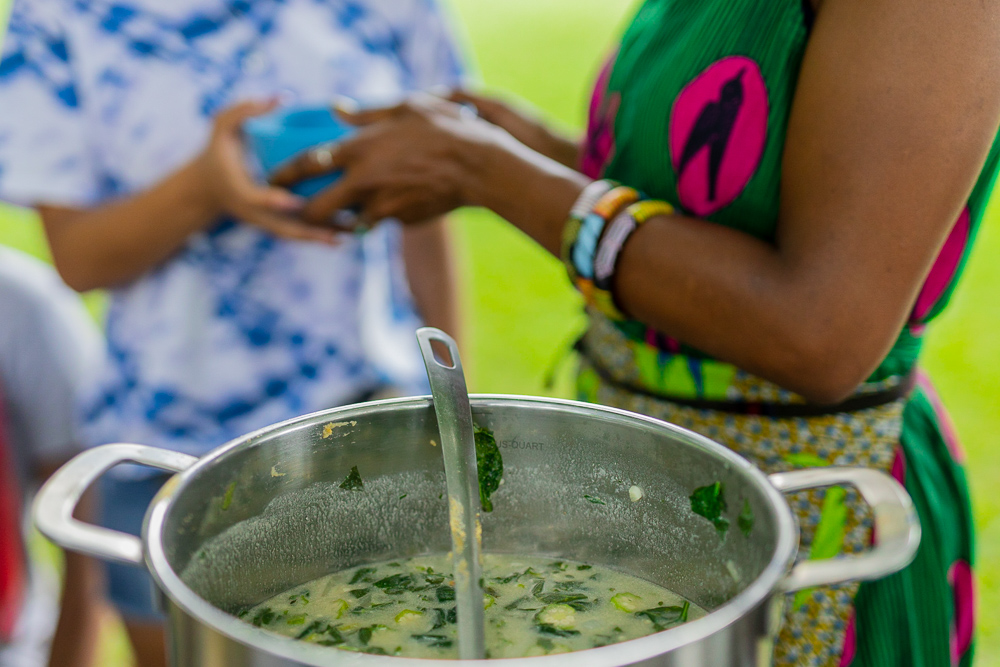Sixteen years ago, in April 2004, NPR’s Morning Edition shared an interview between two of our literary foremothers, authors Alice Walker and Vertamae Smart-Grosvernor, discussing the work of Zora Neale Hurston. For Alice, Zora embodied the “disciplined loving authority of the grandmother spirit of the earth.” “It is the grandmother spirit—the strong grandmother, the centered grandmother, the no-nonsense grandmother—that’s what’s missing in this culture,” Alice tells Vertamae. “That’s who should be speaking to us now. In this hour.”
These words were just as true in this hour in which we find ourselves as they were sixteen years ago. Our planet is in a state of spiritual, cultural, and ecological grief. And still, Zora and other Black artists continue to provide us “cultural nourishment and spiritual food” with their stories and documentation of the past. Lessons for the future. This is the role of the Grand Mother spirit: to nourish and to feed us with her various gifts. The Grand Mother spirit is not solely tied to womanhood or motherhood. Zora herself carried no children, and yet, like Alice, we consider ourselves her spiritual daughters.
Fam, if this ain’t hard times that require furious, furious dancing.
We can all embrace and embody the Grand Mother spirit. Mama Alice gives us instructions in her poem “Calling All Grand Mothers,”

And this piece can be found in Walker’s book of poetry Hard Times Require Furious Dancing. Fam, if this ain’t hard times that require furious, furious dancing. Alice makes it plain that we must live differently or die in the same old ways. This event will change us, how we relate to each other, how we work and play, how we care for ourselves, and, hopefully, one another.

Inspired by Alice and the Grand Mother spirit, we “come out of the kitchen” and offer one of the ways that we maintain our health, our happiness, and our sanity. A recipe for when you need sustenance, wanting to feel nourished and held: an easy pantry broth.

Khaliah D. Pitts and Shivon Pearl Love of Our Mothers’ Kitchens. Photo: Gabrielle Clark. Courtesy Our Mothers’ Kitchens.
Broth (or stock) is a staple in Black kitchens across the diaspora, especially during the cooler months. Many of us are familiar with making broth inadvertently, in the form of potlikker, or the nutrient-dense liquid remaining after cooking greens or beans. Broths are an embodiment of resilience, preparation, and thriving. A broth can be eaten the day of, kept in the fridge for up to a week or immediately frozen and stored for up to 3 months (thaw your frozen broth in a warm water bath). Through the cold months, allergy seasons, or stressful times like we find ourselves in now, a good broth calls forth the scents, flavors, and memories from better times.
Cooking and freezing broth was one of the very first things Khaliah did in preparation for pandemic-induced isolation, unsure of whether stores would remain open. Shivon makes at least one pot a week, each time slightly different than the one before. We both like to use broth in ramen-style dishes combining noodles, vegetables, and herbs, as a flavorful base for sauteed vegetables, soups, and stews, the start of potlikker for greens, or simply sipped as soothing medicine. Started with a base of aromatics, the broth builds internal heat, from the first taste, spreading across your chest and back, lovingly caressing your arms, kissing your face, and coming to rest, satisfyingly in your belly.
This broth recipe was inspired by one of our own grandmothers, Shivon’s Grandma Pearl, who taught her to lean into nature for comfort and care. Next time you’re in need of sustenance, warmth or something to soothe a melancholy, we suggest reading Alice Walker’s Hard Times Require Furious Dancing, while listening to Girl.Grand Mother,God., an Our Mothers’ Kitchens playlist dedicated to Mama Alice, and savoring your own homemade Nourishing Pantry Broth.

Photo: Gabrielle Clark. Courtesy Our Mothers’ Kitchens.
Nourishing Pantry Broth
What you’ll need:
What you have. These ingredients are just suggestions, based on what is usually on hand in our pantries. They vary by season, location, availability and budget. We also don’t measure these ingredients. If cooking just for yourself, cook less. For others, cook more. Trust your eye. Matter of fact, trust all your senses.
Fat:
oil of choice
Aromatics:
ginger, garlic, turmeric, onion, shallot – finely sliced, diced, chopped or grated. Just try to keep the cutting method consistent among them as they will all go in together and you want them to cook at the same pace.
Liquid:
water, homemade or store bought stock, coconut milk
Texture:
tofu, mushrooms, beans, hearty vegetables or meat of your choice
Finish:
roughly chopped fresh herbs, scallions, cilantro, sesame seeds, lime juice, vinegar, oil, red pepper flakes, chili paste, miso
In a medium saucepan, heat oil until it moves freely across the bottom of the pan.
Add any combination of aromatics. Base quantities on your preference and what your body is asking for in that moment. We generally use ginger, garlic and turmeric root. Stir gently, sauteeing over medium-low heat until they are fragrant and begin to soften, about 2-3 mins.
Stir in a textural component or protein. This recipe uses shiitake mushrooms. Saute mushrooms along with aromatics, adding more oil if the pan starts to feel sticky.
Once mushrooms begin to soften, slowly begin adding in liquid. Stirring as you go. You can add a lil salt and pepper here. But if you are using a store bought stock or miso, hold off on salt. We sometimes add coconut milk if we need some extra grounding, or desire a creamier consistency.
Allow to simmer for 10-15 mins. Taste and make adjustments, layering in any additional flavor components you desire. Or don’t.
Broth should be fragrant and full-bodied by this point. Here is when you can add in some ramen or other noodles. Cook for approx. 5 mins until noodles are ready.
If you plan to add miso paste: Now turn off the heat, or turn down low and then stir in miso. Avoid letting miso boil as it will kill the probiotics, which are good for digestive health.
Once all components are to your liking, serve and top with fresh herbs and your choice of acidity like lime juice or vinegar and some red pepper flakes.
Give thanks and be well.